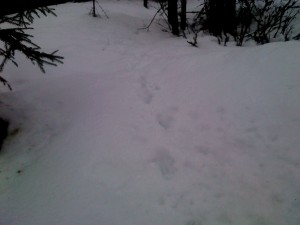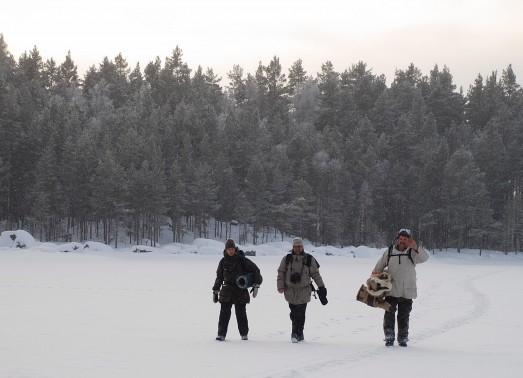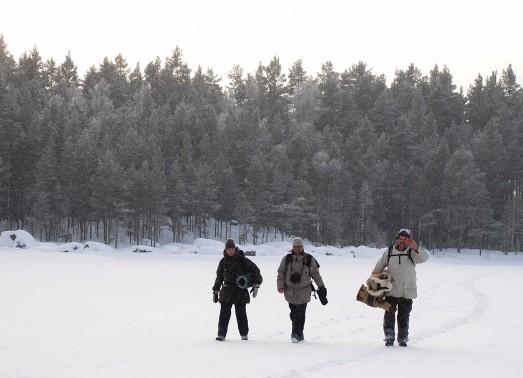Last year, hunting was implemented as one of the tools for managing the Swedish wolf population. The legislation was supported by close to 80 % of the Members of Parliament and regulating the wolf population through hunting is supported by a majority of the Swedes. The decision was, however, considered controversial amongst conservation bodies in Sweden and abroad. With this year’s hunt under way, wolf management again attracts attention nationally and internationally.
I am the Conservation Manager of the Swedish Association for Hunting and Wildlife Management (SAHWM), which was founded in 1830 to restore, preserve and manage game populations. One of my tasks is to write about wildlife management and hunting on SAHWM:s blog. As our wolf management has attracted international attention, I will try to give some insights into Swedish game management, and particularly wolf management, in English also.
The Swedish Wolf Population
Wolves were hunted in Sweden until the sixties and were extinct for about a decade or so, before establishing themselves again in the early eighties. Today, the population numbers at least 250-300 individuals and was increasing by 16 % annually. In 2009, the Swedish Parliament decided to attempt to maintain the population at the current level. This is done through hunting specific individuals that have taken livestock or pets repeatedly. This can only be done after application to the county board, but owners are also allowed to defend livestock and pets that are under direct attack. There is some additional, strictly controlled, hunting in areas with reproducing wolves in order to maintain a constant population size. The quotas are set taking any previous mortality into consideration and were approximately 10 % of the population in 2010. This year’s monitoring could not be finished before the quotas were determined and this year’s bag limit will be a smaller percentage of the actual population. The goal of a constant wolf population is temporary and will be evaluated in 2012.
Already in the eighties, the Swedish parliament decided that reproducing wolves should not be allowed to remain inside the reindeer husbandry area, which comprises the northernmost 40 % of Sweden. This decision was taken to ensure that the indigenous Sami people could maintain current levels of reindeer husbandry. At the same time, however, this effectively reduced contact between the increasing Swedish wolf population and the Finnish and Russian wolves. The current distribution of wolves covers about 20-25 % of Sweden, just south of the reindeer area.
Swedish Wolf Genetics
The current population was founded by two individuals, first breeding in 1983. Only three new immigrants have entered the breeding population since then. As a result, the Swedish population is highly inbred and all individuals except those descended from the two most recent immigrants are more closely related than full-siblings. So far, litter size has been shown to be reduced by inbreeding and some malformations have been found. Serious effects of inbreeding appear to be rare, however. Even so, low genetic variation remains a serious threat to long term population viability. As a result, plans for translocations of wolfs are being drawn up. Also, the decision not to have wolves in the reindeer area has been questioned, which would enable natural contact between the populations.
Attitudes to wolves
There is strong public support for having the wolf in Sweden and the support is increasing at the national level. In 2009, 71 % of the Swedes expressed that they were pleased to have wolves in Sweden, as compared to 64 % in 2004. At the same time, the support in the counties actually harbouring the wolves is decreasing. At the two extremes is the county of Stockholm, where 81 % were positive to having wolves in Sweden, and the county of Dalarna, where only 56 % were positive. Furthermore, a majority of the population is in favour of decreasing the national target for the wolf population in several of the municipalities within the counties with wolves.
Sweden has got approx 270 wolves, 3200 brown bears, 700 wolverines, 1500-1800 lynx and at least 1800 golden eagles. Excluding reindeer (which are held where wolfs basically don’t occur), the 270 or so wolves are responsible for 71 % of all attacks on livestock and pets from any of the large predators. There is a strong support at the national level in Sweden for regulating the wolf population through hunting, to decrease the risk of wolfs taking livestock or pets.
Thus, the average Swede wants to have a viable wolf population, but feels that the population should be regulated to decrease conflicts and problems. The acceptance of the wolf is decreasing where it occurs, which may be a serious threat to the conservation and management of the wolf, unless counteracted.
Wolf Management
Several scientific evaluations of the Swedish wolf population show that it is viable at the current population size, given that there is immigration from Finland every second year or so (and given that the immigrants breed). Alternatively, targets for viability may be reached through translocation of pups or adults from other populations. Current acceptance of the wolf is decreasing where it occurs and the adopted management strategy strives to gain acceptance for translocations by freezing the population at the current level. Thus, improving the genetic status of the wolf population goes hand in hand with regulating the population size through hunting.
Currently, Sweden has been criticized by the EU because the wolves are not allowed to reproduce in the reindeer area. Simultaneously, the UN is criticizing Sweden because it is felt that the number of large predators makes reindeer husbandry difficult. Up to 50 000 of the 250 000 reindeer in Sweden are taken annually, predominantly by the lynx. Adding wolves to the existing lynx, brown bear and wolverine populations would make the problems much larger. This illustrates that large carnivore management is a complex issue and that biological, social and societal issues must be handled simultaneously.
The public attitudes to the wolf, where it occurs, more or less preclude increasing population size further, at least with the current distribution. Furthermore, densities and dissent are currently high in some areas and need to be reduced through direct actions, including hunting. If the wolf population is allowed to expand, thus decreasing local densities and increasing acceptance, a sustainable management of the wolf population can be achieved at the current population size.
Hunting the Wolf
The Swedish wolf population is one of the best studied populations in the world. We have good estimates of the growth rate of the population and the distribution of individuals. Furthermore, we have an almost perfect pedigree for the whole population, meaning that we know which individuals are inbred and which are not. Sweden has a track record of succeeding first with a sustainable management of the brown bear and more recently with the lynx. Both populations were in a situation similar to that of the wolf a couple of decades ago. Through extensive monitoring and conservation work, in combination with limited and strongly regulated hunting, the populations have been able to grow and expand. Allowing limited hunting was one of the key active measures taken to increase acceptance for large carnivores where they occur. This obviously has worked and the EU experts on management of large carnivores, LCIE, strongly support the Swedish wolf management strategy, including limited hunting.
The Swedish wolf packs inhabit large territories, on average 1000 km2. In order to reduce the risk that any of the recent immigrants or their offspring are killed, hunting is only allowed in territories inhabited by inbred individuals. This strategy proved successful in 2010, when no offspring to recent immigrants were killed during the hunting season. As far as we know, this has also been true for the season of 2011. As a result of culling inbred individuals only, average levels of inbreeding have decreased in the population. With the addition of new immigrants, or translocations planned for in the absence of immigration in 2011, the genetic status of the Swedish wolf population will be improved. In this manner, the Swedish wolf population will reach the viability goal set, given that immigration occurs regularly or that translocations are performed.
The Position of the Swedish Hunters
Hunting has strong traditions and a high acceptance in the Swedish society; game management, including hunting, is supported by 86 % of the Swedes. The Swedish Association for Hunting and Wildlife Management is amongst Sweden’s largest NGO:s, with 190 000 members out of Sweden’s 265 000 hunters. We support viable populations of all species native to Sweden, including the large carnivores. We regard wise use of our native game populations as an intrinsic part of a sustainable society and feel that it is essential to focus not only on preserving biodiversity, but also to sustainably use it and restore biodiversity already lost. Here, regulating game populations, and adapting other forms of land use to game management, provides valuable contributions. The principles underlying the current Swedish management of the large carnivores constitute an integral part of our view on game management and wise use of our natural resources.
In short, regulating the wolf population provides the local acceptance necessary for its conservation.
Fredrik Widemo is Associate Professor in Animal Ecology and the Conservation Manager at the Swedish Association for Hunting and Wildlife Management. He is acting as SAHWM:s expert on the effects of wildlife management, and other forms of land use, on biodiversity.
SAHWM is an NGO, but holds a public commission to inform hunters and the public about game, game management and hunting. Also, SAHWM is in charge of game monitoring and of training hunters in Sweden.






